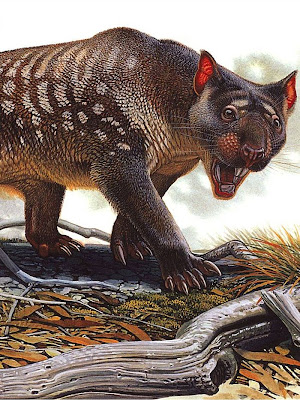Winners are grinners: After the ancient extinction, some animals, like Asilisaurus, had more restricted ranges (Source: Marlene Donnelly/Field Museum of Natural History)
Jennifer Viegas
The study, published in Proceedings of the National Academy of Sciences , reveals how the end-Permian mass extinction 252.3 million years ago permitted a significant reorganisation of terrestrial animals living in the southern part of the supercontinent Pangea.
Out of this chaos emerged the dinosaur predecessors, which likely ushered in the Dinosaur Age.
There were losers, such as fat lizard-looking Dicynodon, which sported a short tail and a turtle's head. It completely bit the dust after the huge extinction event, which led to the disappearance of 90 per cent of all life on the planet.
On the winners' side were silesaurs, which were plant-eaters very closely related to dinosaurs.
"In Tanzania, the main silesaur that we find is called Asilisaurus kongwe," says study co-author Kenneth Angielczyk.
"Asilisaurus was about the size of a medium dog, like a golden retriever, and they tended to have long thin limbs."
Yet another fossil find was Nyasasaurus parringtoni, a Labrador retriever-sized animal with a one-and-a-half-metre-long tail.
Nyasasaurus is either the oldest known dinosaur or the closest known relative of dinosaurs, but we can't completely rule out either option because the material is rather fragmentary," says Angielczyk, who is Associate Curator of Paleomammalogy at the Field Museum of Natural History.
Angielczyk and his colleagues unearthed these creatures over the course of seven fossil-hunting expeditions in Tanzania, Zambia and Antarctica.
The researchers created two "snapshots" of four-legged animals about five million years before the mass extinction event, and 10 million years after it.
Great Dying
The cause of the great die-off remains a mystery, with intense volcanic activity, a meteorite strike and extreme global warming all possible candidates.Before the extinction event, 35 per cent of four-legged species were found in the majority of the areas studied, with some species having ranges that stretched 2600 kilometres.
Ten million years after the die-off, just seven per cent of species were found in the same number of areas.
In addition to the already mentioned animals, the survivors included other archosaurs, which is a group that includes modern crocodiles, modern birds and -- back in the day -- dinosaurs.
Cynodonts also lived through the onslaught. This group later evolved into mammals, so these were our very distant ancestors. Certain additional reptiles and amphibians survived too.
While the fossil discoveries would seem to suggest that the motherland for dinosaurs was Africa, the researchers point out that landmasses were configured very differently then.
What is now Africa was part of Gondwanaland, the southern portion of Pangea.
True dinosaurs first show up about 230 million years ago from what is now Argentina says co-author and geologist Sterling Nesbitt of the Field Museum of Natural History.
"We think that dinosaurs first evolved in Gondwanaland-including Africa, South America, India, Madagascar, Australia, and Antarctica," he says.
Bruce Rubidge, a dinosaur specialist at the University of Witwatersrand, says the expeditions by this team of researchers to little-explored Permian and Triassic-aged depositional basins in Africa and Antarctica, which form part of the supercontinent Gondwana, "has greatly enhanced our understanding of the distribution of land-living vertebrates that lived more than 200 million years ago."
"The results of this research provide documentation of distribution, both in time and space, of important land living vertebrates soon after the greatest extinction event of all times and indicate how the post extinction recovery fauna evolved and became distributed around the world," says Rubidge.
The study could serve as a warning to us, since humans are now contributing to yet another mass extinction event. The Triassic animals were only just starting to recover eight million years after the huge die-off.
"Eight million years is a long time to wait," says Angielczyk. "If we value the communities of organisms around us, conserving and protecting them is the main way we can ensure they will persist."


